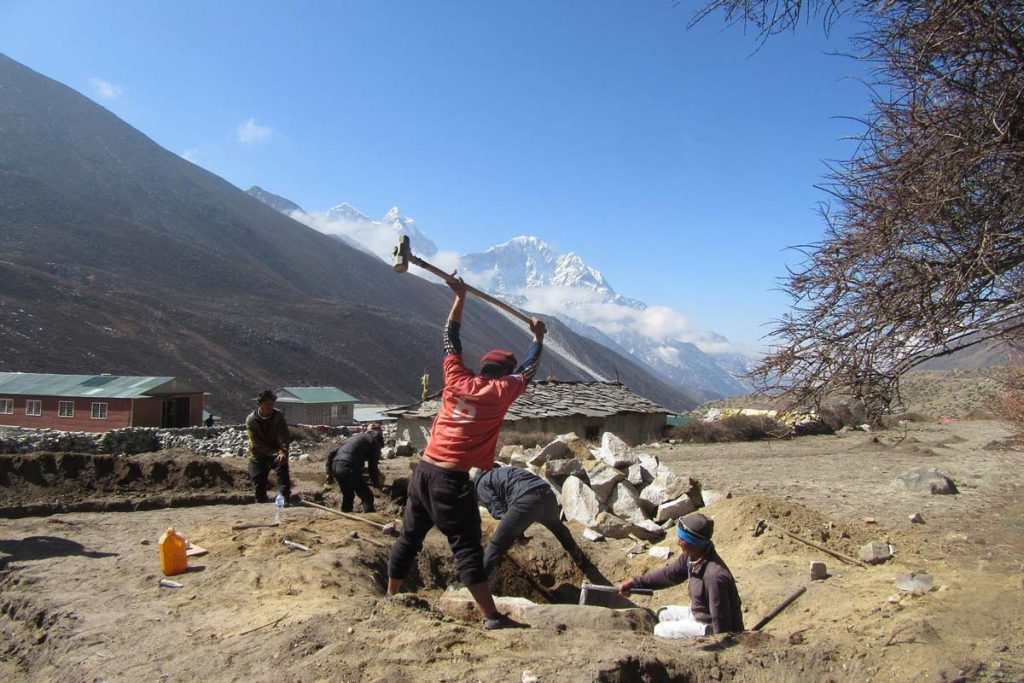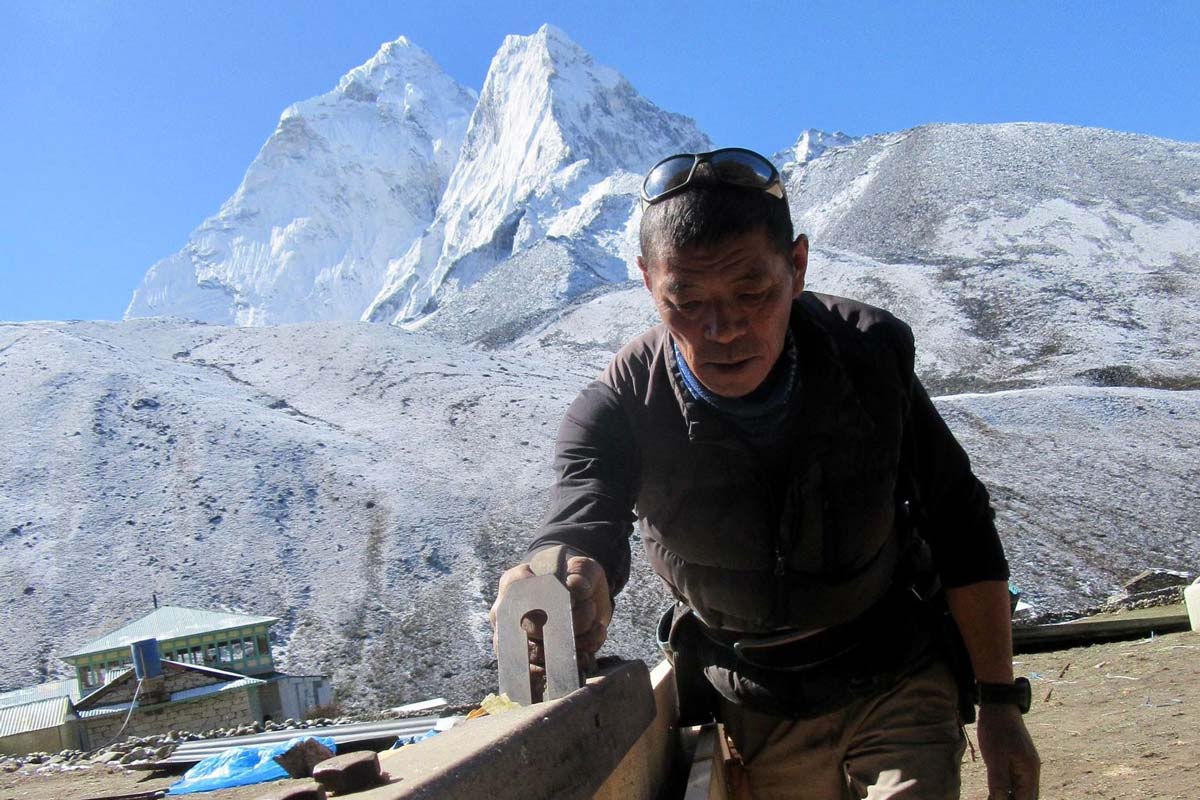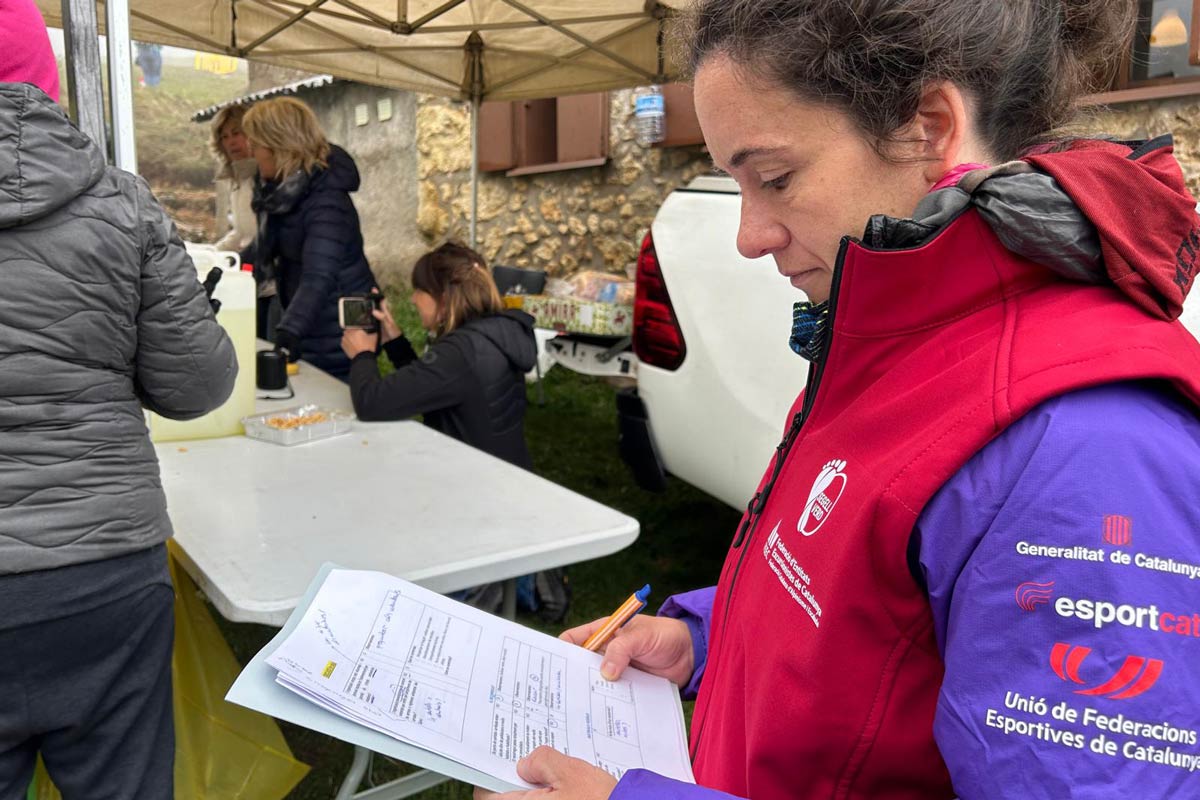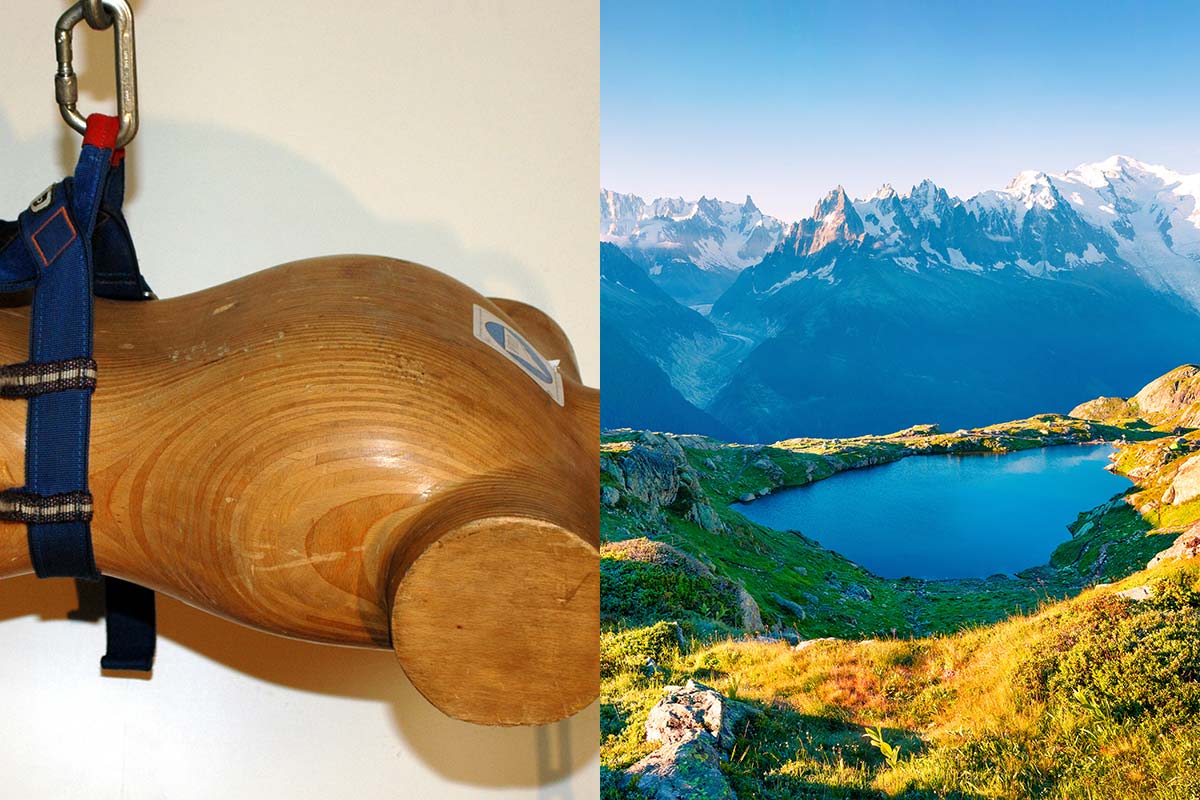OVERVIEW
Around Mount Everest in the Sagarmatha National Park, Nepal, waste plastic has become a major problem. Visitor numbers continue to grow with over two million plastic drinks bottles now needing disposal every year. Some are flown back to Kathmandu but many are buried or burnt.
To deal with this problem, The Khumbu Sherpa Project (KSP), a small charity founded in Scotland, has joined forces with the Namche Youth Club to transform waste plastic bottles into eco- friendly polyester wool, an insulation material that can be used in buildings, clothing and bedding. The process is straightforward. Using a 3kw power supply from the local hydro- electric scheme, a machine turns entire bottles into plastic chips which in turn are then converted into polyester wool.
—
Vision, goals and objectives
The Sagarmatha National Park attracts approximately 60,000 visitors per year who in purchasing bottled water, account for circa 2,000,000 plastic bottles per year. Whilst there are recent initiatives for visitors to carry waste out, the majority is still buried or burnt. With only very few exceptions the accommodation in the Khumbu is basic with cold uninsulated rooms in stone buildings, lined internally with thin timber boards or ply. Recently ‘sandwich panel’ buildings have been introduced but many of these also remain cold with little insulation. Insulation is currently unaffordable or unavailable for many and heating is primarily based on burning yak dung. It is prohibited to cut trees and shrubs & above Namche Bazar mains hydro power is almost unknown. In Pangboche at 3,900 metres the village scheme produces 9kw at full capacity which is shared between 400 people.
Yak herds are in decline with freight increasingly by helicopter sling loads. As a consequence, dung is now in short supply with increased competition between its use for heating and for fertilising crops.
The Khumbu Sherpa Project was originally established to address the urgent need for disaster relief & building reconstruction following the devastating earthquake of 2015. Various projects grew from this including the Recycling Plastic Waste into Insulation in Khumbu Project which commenced in 2019.
The vision of this project is to turn the problem of waste plastic bottles into a permanent solution resolving the shortage of affordable insulation throughout the tourist regions of Himalaya. This in turn will lead to less Yak dung being used for heating, leaving more available for agriculture. In upgrading to warmer more comfortable accommodation, lodge owners will be able to charge for better services and therefore keep more tourism dollars in the local community. Equally importantly something which is currently waste will become of value. Potentially porters can be paid to collect bottles providing an important source of additional income.
After involving residents of Namche Bazar, allied with a Europe wide research, an innovative machine was identified in Bulgaria which converts waste plastic bottles into polyester wool perfectly suited to building insulation. Only requiring a 3kw power supply and a small amount of water, 38 x 500ml bottles will produce one square metre of 100mm diameter insulation. One machine has already been purchased and has just arrived in Kathmandu.
Our objective is that in coming months, the machine will be installed in Namche Bazar where with the support from the Sagarmatha Pollution Control Committee (SPCC) & backed by a small Scottish registered charity, the project will be run initially on a trial basis by Namche Youth Club. Dependent upon additional funding being secured, the project will then be upscaled, and a key goal is that in year two the project will be rolled out across more communities. Bottles will be purchased from returning porters and the plastic bottle waste problem will become a solution to the problem of inadequate insulation & its knock on impact on yak dung availability for agriculture.

Expected implementation and outcomes
1. Fund raising for the first machine – Ongoing with current financial support from outdoor manufacturers Mountain Equipment & Fjallraven. Additional support provided by HRH The Prince of Wales (Colonel in Chief of the Ghurkha Regiment & a keen Himalayan trekker) as well as donations from other benefactors.
2. Purchase of the first machine – completed
3. Shipping from Europe – completed
4. Temporary storage in Kathmandu – Agreement reached with the Rotary Club of Kathmandu
5. Supply of spares – Readily sourced & shipped as required from the Bulgarian manufacturer
6. Conversion of suitable building – Location identified; materials imported & construction has commenced with building due for completion early autumn 2022.
7. Installation of machine – Autumn 2022
8. Installation, repairs & maintenance training – appoint & train someone local – Autumn 2202
9. Once production of polyester wool commences, a local sales channel needs to be established – currently under discussion locally.
Milestones
October 2019: Initial meeting in Kathmandu with SPCC Chairman to discuss idea.
2021: Initial funding secured allowing first phase of the project to progress.
January 2022: Agreement reached with initial partners.
January 2022: Purchase hardware from Bulgaria.
February 2022: Hardware shipped by sea-overland from UK to Kathmandu
March – June 2022: Ongoing training with local builders on use of vapour barriers, insulation and chimney safety best practice.
March 2022: Namche meeting with Namche Youth Club Chairman.
September 2022: Local Khumbu resident travels to Europe for training.
October 2022: Installation of hardware and onsite training.
November 2022: First insulation produced.
November 2022: Builder training in appropriate use.
Spring 2023: Production ramped up as supply of waste bottles established
Summer 2023: Polyester wool incorporated into new build construction
Late 2023: Rollout of project into other communities
Outcomes
1. Polyester wool suitable for multiple applications manufactured from plastic bottles
2. Reduced littering & waste
3. Low cost affordable insulation for both private homes & tourist lodges
4. Better living conditions for local residents in winter
5. Increased income from tourism
6. Increased agricultural yield as a result of an increase in the availability of Yak dung.
Climbing, mountaineering or outdoor sport focus
The Sagarmatha National Park is the home of some of the highest mountains on the planet and is a world heritage site. It is a high profile mountaineering destination for many climbers and the area sees huge numbers of trekkers visiting every year. All of these visitors require housing & are increasingly looking for a more comfortable trip without having to endure the basic cold accommodation which is the current norm in the area.
Best practice in mountaineering and mountain-based sports for mountain protection
This project is innovative where the problem becomes a solution.
Possibly controversially, we feel many mountain focussed environmental projects are unintentionally aimed at Western audiences. Whilst by necessity this project is in the name of a Scottish based registered charity, it is really an application that has the support of the people of the Khumbu, and the approval of the Namche Youth Club.
Completing this application from Dingboche, where we are currently working with local tradesman, is impossible.
There’s no stable internet so each section has to be written & then after several attempts sent electronically to Scotland where someone else has to submit this application. As well as costly in time, this helps to support a ‘Business as usual’ approach to such awards. Instead ‘going beyond’ should mean reaching out more effectively to remote and poorly connected communities where IT, language skills and familiarity with grant application procedures is limited.
Hence, we believe the mountaineering community should provide well thought out and justified ‘kick starter’ support to this region where low income is the norm, business development is difficult & loan interest rates are prohibitive. Projects such as ours will enable economically active locals stay rather than to leave the region.
Sustainability is not just about the environment but also about the rural economy, a key theme of this project since it tackles one undesirable element of mountaineering (waste plastic) whilst also directly improving building insulation & indirectly agricultural productivity (sustainable resource consumption). In turn this feeding through to the local economy via increased income (in turn helping local traditions & providing income to improve education). The project in effect offers a virtuous circle since as well as delivering local benefits it will also help towards improved visitor accommodation for budget mountaineers & trekkers.
Additional Information
For most rural Sherpa families building insulation is currently unaffordable resulting in homes and tourist lodges being cold with large quantities of increasingly scarce yak dung being burnt for warmth. However, by using this new low-cost insulation, the amount of dung needed for heating will reduce which in turn will leave more for organic fertiliser.
With enthusiastic backing from the Sagarmatha Pollution Control Committee (SPCC), established thirty years ago by the Sherpa people to manage waste, as well as the Nepal Mountaineering Association, this is an exciting project which has the potential to be replicated in other mountain areas.
The project is supported by outdoor brands Mountain Equipment and Fjallraven, The Prince of Wales Charitable Fund as well as other private donors.
In addition to the production of the insulation from the waste plastic the KSP team have been working with local tradesmen demonstrating how materials such as vapour barriers and insulation can be used effectively and safely. Promoting fire safety, in particular in relation to stove pipe installations has become an increasingly important part of the work to which the Khumbu Sherpa Project team are extremely grateful to UK charity, Fire Aid, for their assistance.
—
To discover more about the UIAA Mountain Protection Award please click here.



